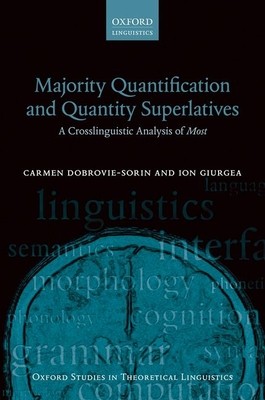
- We will send in 10–14 business days.
- Author: Carmen Dobrovie-Sorin
- Publisher: Oxford University Press, USA
- ISBN-10: 0198791240
- ISBN-13: 9780198791249
- Format: 16.3 x 23.6 x 2.8 cm, hardcover
- Language: English
- SAVE -10% with code: EXTRA
Majority Quantification and Quantity Superlatives (e-book) (used book) | bookbook.eu
Reviews
Description
This book investigates the syntax and semantics of proportional most and other majority quantifiers across languages. Carmen Dobrovie-Sorin and Ion Giurgea draw on data from around 40 languages to demonstrate the existence of two distinct semantic types of most: a distributive type, which
compares cardinalities of sets of atoms, and a cumulative type, which involves measuring plural and mass entities with respect to a whole. On the syntactic side, the most significant difference is between partitive and non-partitive configurations: certain majority quantifiers are specific to
partitive constructions, while others are also allowed in non-partitives. The volume also explores complex expressions of the type the largest part and nominal quantifiers of the type the majority. The authors argue in favour of a quantificational analysis of most, in contrast to many recent
studies, but adopt a bipartition-cum-superlative analysis for the largest part.
(in)definiteness marking, and other crucial issues in linguistic theory.
EXTRA 10 % discount with code: EXTRA
The promotion ends in 13d.12:06:13
The discount code is valid when purchasing from 10 €. Discounts do not stack.
- Author: Carmen Dobrovie-Sorin
- Publisher: Oxford University Press, USA
- ISBN-10: 0198791240
- ISBN-13: 9780198791249
- Format: 16.3 x 23.6 x 2.8 cm, hardcover
- Language: English English
This book investigates the syntax and semantics of proportional most and other majority quantifiers across languages. Carmen Dobrovie-Sorin and Ion Giurgea draw on data from around 40 languages to demonstrate the existence of two distinct semantic types of most: a distributive type, which
compares cardinalities of sets of atoms, and a cumulative type, which involves measuring plural and mass entities with respect to a whole. On the syntactic side, the most significant difference is between partitive and non-partitive configurations: certain majority quantifiers are specific to
partitive constructions, while others are also allowed in non-partitives. The volume also explores complex expressions of the type the largest part and nominal quantifiers of the type the majority. The authors argue in favour of a quantificational analysis of most, in contrast to many recent
studies, but adopt a bipartition-cum-superlative analysis for the largest part.
(in)definiteness marking, and other crucial issues in linguistic theory.


Reviews